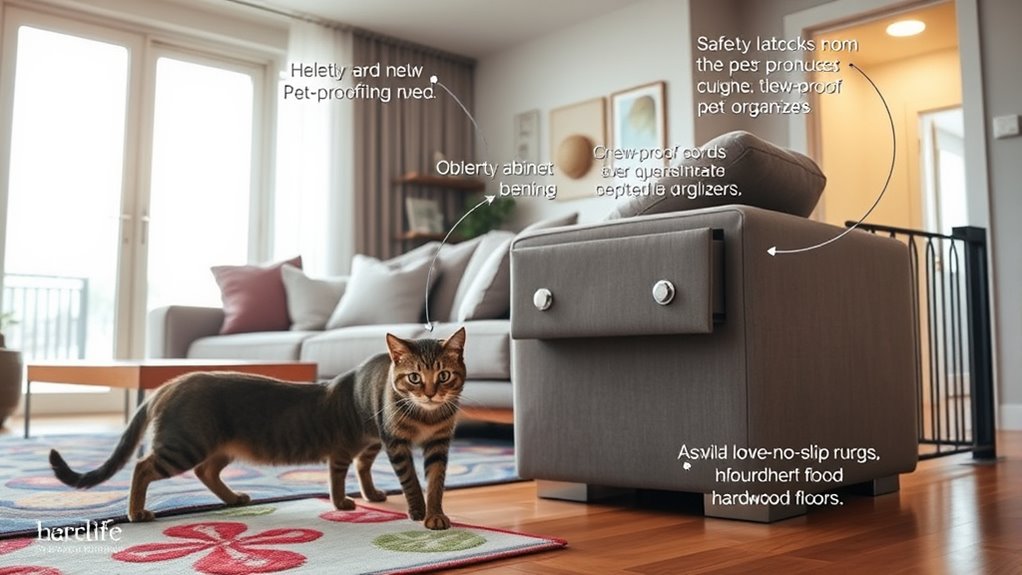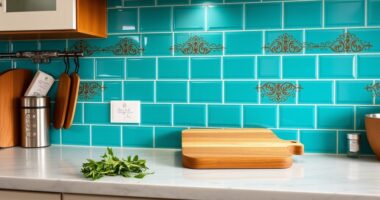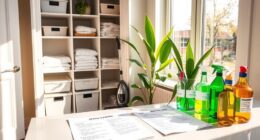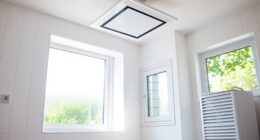To pet-proof your home, start by securing hazardous materials like cleaning supplies, medications, and small objects out of your pets’ reach. Use corner protectors on furniture, secure loose cords, and choose pet-safe plants. Regularly remove clutter and clean up small items that could be swallowed. Create a designated safe space free of hazards for your pets to relax. If you keep these tips in mind, you’ll better protect both your belongings and your pets from harm.
Key Takeaways
- Store cleaning supplies, medications, and hazardous plants securely out of pets’ reach.
- Use corner protectors and secure furniture to prevent injuries and tipping hazards.
- Keep small objects, coins, and jewelry off floors and countertops to prevent choking risks.
- Verify houseplants are non-toxic and cover electrical cords to prevent chewing.
- Designate a pet-safe area and regularly inspect your home for new hazards.

Bringing a pet into your home means you need to make it safe for their curious nature. Pets are naturally inquisitive, and their desire to explore can lead them into dangerous situations if you’re not careful. One of the most important steps is identifying and removing hazardous materials that could harm them. Cleaning supplies, medications, and certain plants should be stored securely out of reach. Even household items like batteries or small objects can pose choking hazards. Ensuring these items are safely tucked away prevents accidents and keeps your furry friend safe.
Pet-proof your home by safely storing hazardous materials and removing choking risks.
Furniture safety is another critical aspect of pet-proofing your space. Sharp edges on tables, coffee tables, or other furniture pieces can cause injuries if your pet bumps into them. Consider applying corner protectors or padding to sharp corners to minimize injury risk. Additionally, some furniture might be unstable or easy for pets to topple over, especially if they like to climb or jump. Securing furniture to the wall or choosing pet-friendly, stable pieces can prevent accidents. If you have loose cords dangling from blinds or electronic devices, make sure to hide or secure them. Pets, especially puppies and kittens, often chew on cords, risking electric shock or strangulation.
Clutter and small objects left on countertops or floors can also be tempting for pets to chew or swallow. Regularly clean up small items like coins, jewelry, or children’s toys. Not only do they pose a choking hazard, but ingesting non-food items can result in costly vet visits. Be cautious with trash cans—use lids or bins with secure lids to prevent pets from rummaging through them, which can expose them to spoiled food or harmful substances.
If you have plants, double-check that they’re non-toxic to pets. Many common houseplants are hazardous if ingested, so research and replace any risky greenery with pet-safe alternatives. Some houseplants are particularly toxic, and knowing which ones to avoid is essential for pet safety. Also, consider covering or blocking access to areas with exposed electrical outlets or cords, as pets may chew on them, risking electrocution.
Finally, create a designated safe space where your pet can relax and feel secure. This area should be free of hazards, clutter, and hazardous materials, providing a refuge for your pet to unwind. Regularly inspect your home for new hazards, especially if you’re bringing in new furniture or decorations, and adjust your pet-proofing efforts accordingly. By proactively addressing hazardous materials and ensuring furniture safety, you set the foundation for a happy, healthy environment where your pet can thrive safely alongside you.
Frequently Asked Questions
How Can I Pet-Proof Outdoor Areas Effectively?
To pet-proof outdoor areas effectively, start by installing secure outdoor fencing to prevent escapes. Regularly check for hazard identification, like toxic plants, sharp objects, or gaps in the fence. Remove or secure items that could harm your pets. Confirm gates are latched and sturdy. By taking these steps, you create a safe environment where your pets can play freely without risking their safety or causing damage.
What Are the Best Non-Toxic Plants Safe for Pets?
When choosing indoor plants for pet safety, opt for non-toxic options like spider plants, Boston ferns, or areca palms. You can incorporate these into your home without worry, knowing they won’t harm your pets if they nibble. Always research each plant before bringing it home to guarantee it’s safe for your specific pets. Creating a pet-safe indoor plant collection helps protect your furry friends while brightening your space.
How Often Should I Check for New Hazards in My Home?
Every day, new hazards could pop up like surprise guests at a party, so you should perform hazard inspections weekly. Regular safety updates help catch hidden dangers before they become disasters. Stay vigilant, checking high and low, behind furniture, and in tricky spots. This ongoing effort keeps your home safe for both your pets and belongings, preventing accidents and ensuring peace of mind as you navigate your busy, unpredictable household.
Are There Pet-Proof Locks for Cabinets and Drawers?
Yes, there are pet-proof locks for cabinets and drawers. You can choose from various lock options like magnetic, spring-loaded, or adhesive-based, all designed to enhance cabinet safety. These locks help prevent your pets from accessing harmful items while still allowing easy access for you. Explore different lock options to find the best fit for your cabinets and guarantee your pet’s safety without sacrificing convenience.
How Can I Train My Pet to Avoid Dangerous Items?
To train your pet to avoid dangerous items, use reward-based training by praising and giving treats when they stay away from hazards. Consistently place safe items in accessible areas and keep dangerous objects out of reach. Redirect their attention to safe toys whenever they approach something risky. Over time, your pet will associate good behavior with rewards and learn to avoid dangerous items on their own, keeping both your home and pets safe.
Conclusion
By pet-proofing your home, you create a safer space for your furry friends and protect your belongings. Did you know that nearly 60% of pet owners have experienced a pet-related accident at home? Taking simple steps like securing cords and storing hazardous items can make a big difference. With a little effort, you’ll enjoy peace of mind knowing your pets are safe and your home stays damage-free. Your pets deserve a secure, loving environment!









